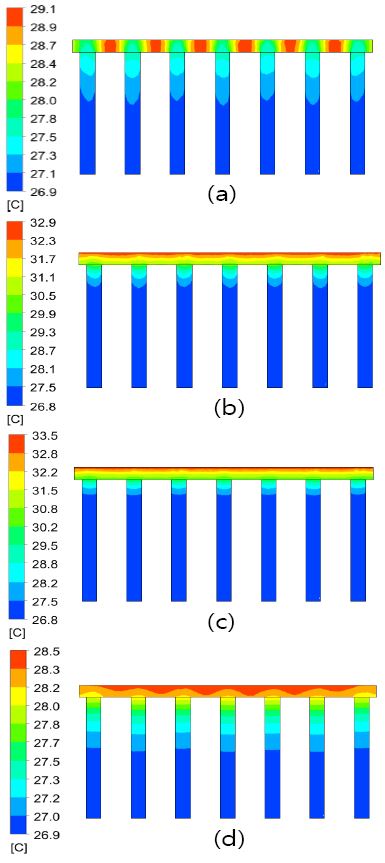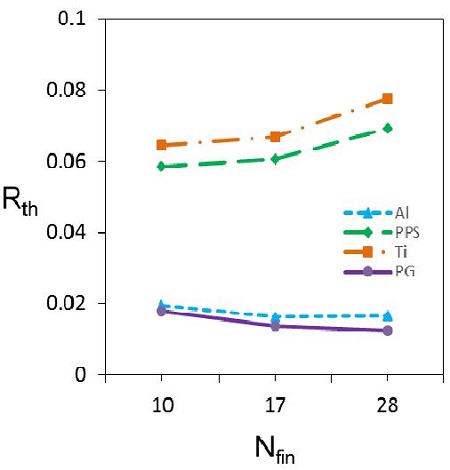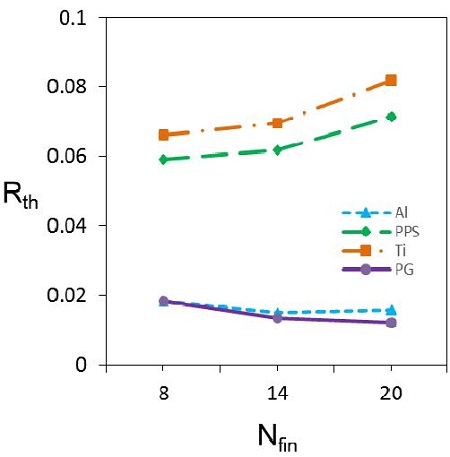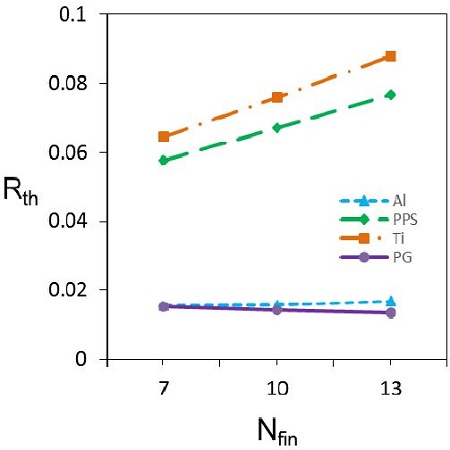
열전폐열회수를 위해 수동적으로 해수냉각되는 폴리머 히트싱크 열성능의 수치적 연구


Copyright © The Korean Society of Marine Engineering
This is an Open Access article distributed under the terms of the Creative Commons Attribution Non-Commercial License (http://creativecommons.org/licenses/by-nc/3.0), which permits unrestricted non-commercial use, distribution, and reproduction in any medium, provided the original work is properly cited.
초록
본 연구에서는 해수를 활용하여 수동적으로 냉각되는 폴리머 히트싱크의 열성능을 전산적으로 탐구한다. 폴리머 히트싱크는 폐열회수를 위한 열전생성기의 저온면의 냉각모듈로 제안되었고, 상세한 수치연구를 위해 3차원 전산유체역학 모델링이 수행되었다. 폴리머 히트싱크의 기본 소재로 polyphenylene sulfide (PPS)와 pyrolytic graphite (PG)가 선택되었고, 전산연구는 다양한 휜 수와 휜 두께에서 PPS와 PG 히트싱크의 성능을 결정하고, 이 결과는 알루미늄 (Al)과 티타늄 (Ti) 히트싱크와 비교된다. 연구결과는 PG 히트싱크가 Ti 히트싱크 보다 3~4배 열성능이 우수함을 보이는데, 이 결과는 Ti 히트싱크보다 더 우수한 PG 히트싱크의 열확산에 기인한 것으로 보인다. 연구결과에 의하면 PG 히트싱크의 열성능에 대한 휜 수 증가의 효과가 PPS와 Ti 히트싱크 경우와는 상반됨을 보이는데, 이는 휜 수 증가에 대한 열확산, 표면적 증대, 유동저항의 상관관계로 설명이 가능하다.
Abstract
This study computationally explored the thermal performance of passively-cooled polymer heat sinks utilizing seawater. Polymer heat sinks are proposed as cooling modules of the cold sides of thermoelectric generators for waste heat recovery. 3-D Computational Fluid Dynamics (CFD) modelling was conducted for a detailed numerical study. Polyphenylene sulfide (PPS) and pyrolytic graphite (PG) were selected for the base materials of polymer heat sinks. The computational study evaluated the performance of the PPS and PG heat sinks at various fin numbers and fin thicknesses. Their performances were compared with those of aluminum (Al) and titanium (Ti) heat sinks. The study results showed that the thermal performance of the PG heat sink was 3~4 times better than that of the Ti heat sink. This might be due mainly to the better heat spreading of the PG heat sink than the Ti heat sink. The effect of the number of fins on the performance of the PG heat sink was dissimilar to the cases of the PPS and Ti heat sinks. This result can be explained by the interrelationships among heat spreading, surface area enhancement, and fluidic resistance incorporating with an increase in the number of fins.
Keywords:
Polymer heat sinks, Seawater, Thermal performance, Computational fluid dynamics키워드:
폴리머 히트싱크, 해수, 열성능, 전산유체역학1. 서 론
최근의 연구경향에[1]-[3] 의하면 기존의 금속소재 기반 히트싱크에 비교하여 에너지 효율적이고 경량화가 가능한 폴리머 복합재 기반의 히트싱크에 대한 기술적 관심이 증대되고 있음을 알 수 있다. A. Bar-Cohen 등은[1][2] 전자장치 냉각용 핀 휜 폴리머 히트싱크의 자연대류상의 특성에 대한 연구를 수행하였고, M. Arik 등은[3] 항공기내 전자장치 냉각용 판 형 폴리머 히트싱크에 대한 연구 결과를 발표하였다. 최근에는 고가의 해수용 금속재 열교환기를 대체할 수 있는 폴리머 복합재 열교환기에 대한 연구가 활발하게 이루어지고 있다[4].
본 연구는 언급된 전자장치 냉각용, 열교환기용이 아닌, 해상에서 폐열회수를 위한 폴리머 히트싱크에 대한 연구이다. 고안된 단일 폐열회수모듈은[5] 열전생성기와[6] 폴리머 히트싱크로 구성되며, 효율적 폐열회수를 위해서는 열전생성기 모듈 저온면의[7] 폴리머 히트싱크에 의한 효과적인 냉각이 매우 중요하다. 저자들의 검색에도 불구하고 이에 대해 유사하게 연구되었거나 연관성이 높은 연구 결과물을 발견하는 것은 불가능하였다. 따라서 본 연구에서는 해수를 수동적으로 활용하는 폴리머 히트싱크의 열성능을 수치적으로 해석하기 위한 연구를 수행하였다.
본 논문은 폴리머 히트싱크의 구조와 소재, CFD 상용 소프트웨어를 활용하여 수행된 폴리머 히트싱크의 전산열유동해석에 대해 설명한다. 다음으로 폴리머 소재인 pyrolytic graphite (PG), polyphenylene sulfide (PPS) 히트싱크와 비교대상인 titanium (Ti), aluminum (Al) 히트싱크의 대표적인 열, 유동, 경계조건에 대해 전산모사된 온도장에 대해 논한다. 마지막으로 다양한 휜 두께와 휜 수에 대하여 계산된 히트싱크의 열저항 결과를 보여주고, 결과의 물리적 의미와 매개변수 영향에 대하여 논의한다.
2. 폴리머 히트싱크
2.1 폴리머 히트싱크 모델
해수에 의해 수동적으로 냉각되는 다양한 구조의 폴리머 판 휜 히트싱크의 열성능을 해석하기 위해 상용소프트웨어인 ANSYS ICEM-CFD를 사용하여 격자생성을, ANSYS Fluent를 사용하여 전산열유동해석을 수행하였다. 모델에는 약 200만개의 격자가 사용되었다.
해수의 유동은 난류 유동으로 가정되었고, 다음의 표준 k-ϵ 방정식이 난류모델 방정식으로 사용되었다[8].
| (1) |
| (2) |
여기에서 k는 난류운동에너지, ϵ은 소산율을 의미하며, ρ,μ, u는 각각 밀도, 점도, 유동속도를 의미한다. Gk, Gb, YM 는 각각 평균속도구배에 기인하는 난류운동에너지의 생성, 부력이 초래하는 난류운동에너지의 생성, 총 소산율에 대한 압축성 난류에서 변동팽창의 공헌도를 나타낸다. C1ϵ, C2ϵ, C3ϵ는 각각 상수들이고, σk, σϵ는 k, ϵ에 대한 난류 Prandtl수이며, Sk, Sϵ는 사용자 정의 source 항들이다. Figure 1은 전산열유동모델의 물리적 구조와 수치, 열유동 경계조건을 도식적으로 보여준다. 작동유체인 해수의 온도는 300K로 설정되었고, 모든 물성치는 물과 동일한 것으로 가정되었다. 유동영역에서 입구조건은 0.1m/s의 균일입구속도로 설정되고, 히트싱크베이스에서는 균일 열유속으로 경계조건이 설정되었다.
2.2 폴리머 히트싱크 소재
열전도율이 우수한 PG, PPS가 폴리머 히트싱크의 소재로 선정되었고, 상대비교연구를 위해 Ti, Al도 히트싱크의 소재로 선정되어 전산 열유동모델에 적용되었다. 여기에서 PG, PPS는 물론 순수 폴리머 소재가 아닌 그래파이트 섬유 또는 입자와 폴리머 소재와의 복합소재이다[3]. Ti 은 부식 저항력이 매우 우수하므로 Al 대비 저조한 열전도율에도 불구하고, 해수를 활용하는 열교환기 소재로 광범위하게 사용되는 소재이다.
히트싱크 소재의 물성치는 Table 1에 제시되어 있고, 모든 물성치는 실온에서의 측정값이다. PG의 경우 면에 수평방향의 열전도율, kin-plane은 370W/m-K 인 반면에 면에 수직방향의 열전도율, kout-of-plane은 6.5W/m-K 로서 PPS 대비 이방성이 매우 크지만 면 수평방향의 열전도율은 PPS 보다 약 20배, 알루미늄보다 약 2배 우수함을 Table 1은 보여준다.
3. 열성능
3.1 온도장
Figure 2 (a)-(d) 에서는 PG, PPS, Ti, Al 히트싱크에서 열밀도가 1W/cm2, 입구유속이 0.1m/s 일 때 전산모사된 히트싱크들의 온도장을 보여주며, 이때 히트싱크 베이스는 100mm x 100mm, 휜의 두께는 5mm, 휜의 높이는 50mm, 휜의 길이는 100mm 이다.

Temperature fields of (a)PG, (b)PPS, (c)Ti, (d)Al at a heat density of 1W/cm2 and an incident water velocity of 0.1m/s
PG 히트싱크의 온도장은 베이스에서 횡방향으로의 열흐름이 지배적이며 종방향으로의 온도구배가 상당함을 보여준다. 이는 베이스 종방향의 열전도율이 횡방향보다 매우 작은 즉 열전도율의 이방성에 기인한 것으로 보인다. PG 히트싱크 베이스의 평균온도는 Ti 히트싱크보다 약 20% 정도 낮음을 보이는데 이는 PG 히트싱크의 열성능이 더 우수함을 의미하며, PG 히트싱크 소재의 우수한 열전도율에 기인한다. 전산모사 결과는 PPS 히트싱크 베이스 평균온도도 Ti 히트싱크 보다 다소 낮음을 보여준다.
3.2 열저항
히트싱크의 열특성 지표로 열저항을 사용하였고, 열저항, Rth 은 다음의 식으로 정의된다[9].
| (3) |
여기서 q는 히트싱크 베이스에 공급되는 총 열율(W), Tb는 히트싱크 베이스의 평균 온도(℃), Tf 는 유체온도(℃) 이다.
Figure 3 ~ 5는 휜 두께가 각각 1mm, 2.5mm, 5mm인 PG, PPS, Ti, Al 히트싱크의 열저항을 휜 수의 함수로 나타낸 수치 계산 결과이다. 전산해석 시에 열밀도, 입구유속, 유체온도, 구조적 변수 값들은 Figure 2의 온도장 해석 시에 사용되었던 변수 값들과 동일하다.

Thermal resistances of the PG, PPS, Ti, Al heat sinks with a fin thickness of 1mm as a function of the number of fins

Thermal resistances of the PG, PPS, Ti, Al heat sinks with a fin thickness of 2.5mm as a function of the number of fins

Thermal resistances of the PG, PPS, Ti, Al heat sinks with a fin thickness of 5mm as a function of the number of fins
계산결과는 휜 수의 변화에도 열저항 크기는 Ti, PPS, Al, PG 히트싱크 순서이며, PG 히트싱크의 열저항이 Ti 히트싱크의 열저항의 약 1/3~1/4로 상대적으로 훨씬 작음을 보여준다. 이는 PG 히트싱크의 열성능이 Ti 히트싱크보다 3.3~4.2 배 더 우수함을 의미한다.
Figure 3은 휜 두께가 1mm일 때 Ti, PPS 히트싱크의 경우에는 휜 수가 증가할수록 열저항이 증가함을 보여주며, 반면에 PG, Al 히트싱크는 휜 수의 증가가 열저항의 감소를 초래함을 보인다.
고전도율을 지닌 PG, Al 히트싱크는 베이스에서 각각의 휜 들까지 열확산이 잘 이루어져 휜 수 증가에 의한 열전달 표면적 확대 효과 혜택을 보지만, Ti, PPS 히트싱크는 상대적으로 저전도율로 인하여 열전달 표면적 확대 효과 혜택보다는 휜 사이 개별 유로의 크기가 감소됨으로 인한 유동저항 증가라는 손실을 입게 되어, 궁극적으로는 열저항의 증가로 나타나는 것으로 보인다.
Figure 4, 5는 2.5mm, 5mm 휜 두께의 히트싱크들도 열저항에 대한 휜 수의 증가 영향은 1mm 두께의 경우와 유사함을 보여준다. 이러한 결과는 언급했던 휜 수 증가에 대한 전도에 의한 열확산, 표면적 증대, 유동저항의 상관관계로 설명이 가능하다.
4. 결 론
본 논문은 해수를 수동적으로 활용하여 폐열회수용 열전생성기의 저온면을 효과적으로 냉각하기 위한 폴리머 히트싱크의 열성능을 전산적으로 탐구한 연구에 대하여 논하였다. pyrolytic graphite (PG), polyphenylene sulfide (PPS) 히트싱크와 비교대상인 titanium (Ti), aluminum (Al) 히트싱크의 열저항을 다양한 휜 두께와 휜 수에 대하여 계산하여 열성능과 매개변수적 영향을 결정하였다.
연구결과에 의하면 PG 히트싱크의 열성능이 Ti 히트싱크보다 3~4배 우수함을 보여준다. 이 결과는 Ti 히트싱크보다 훨씬 더 우수한 PG 히트싱크의 휜 종방향 열전도율에 의한 우수한 열확산에 기인한 것으로 보인다. 또한 연구결과는 Ti, PPS 히트싱크의 경우에는 휜 수가 증가할수록 열저항이 증가함을 보여주지만, PG, Al 히트싱크는 휜 수의 증가가 열저항의 감소를 초래함을 보인다. 이처럼 상이한 결과는 휜 수 증가에 대한 전도 열확산, 표면적 증대, 유동저항의 상관관계로 설명이 가능하다.
Acknowledgments
이 논문은 부경대학교 자율창의학술연구비(2014년)에 의해 연구되었음.
References
-
R. Bahadur, and A. Bar-Cohen, “Thermal design and optimization of natural convection polymer pin fin heat sinks”, IEEE Transactions on Components and Packaging Technologies, 28(2), p238-246, (2005).
[https://doi.org/10.1109/TCAPT.2005.848498]

-
R. Bahadur, and A. Bar-Cohen, “Analysis and design of a least material orthotropic pin fin heat sinks”, Proceedings of the 10th IEEE Intersociety Conference on Thermal and Thermomechanical Phenomena in Electronics Systems, p305-313, (2006).
[https://doi.org/10.1109/itherm.2006.1645357]

-
T. Icoz, and M. Mehmet, “Light weight high performance thermal management with advanced heat sinks and extended surfaces”, IEEE Transactions on Components and Packaging Technologies, 33(1), p161-166, (2010).
[https://doi.org/10.1109/TCAPT.2009.2026736]

-
J. G. Cevallos, A. E. Bergles, A. Bar-Cohen, P. Rodgers, and S. K. Gupta, “Polymer heat exchangers—history, opportunities, and challenges”, Heat Transfer Engineering, 33(13), p1075-1093, (2012).
[https://doi.org/10.1080/01457632.2012.663654]

-
K. J. Kim, F. Cottone, S. Goyal, and J. Punch, “Energy scavenging for energy efficiency in networks and applications”, Bell Labs Technical Journal, 15(2), p7-30, (2010).
[https://doi.org/10.1002/bltj.20438]

-
D. M. Rowe (ed.), CRC Handbook of Thermoelectrics, Boca Raton, USA, CRC, (1995).
[https://doi.org/10.1201/9781420049718]

-
K. J. Kim, “Generation efficiency and thermal performance of a thermoelectric generator with a high power electronic component”, Journal of the Korean Society of Marine Engineering, 36(1), p51-56, (2012).
[https://doi.org/10.5916/jkosme.2012.36.1.51]

- ANSYS Inc, ANSYS Fluent User’s Guide, (2014).
- F. Incropera, D. P. Dewitt, T. L. Bergman, and A. S. Lavine, Principles of Heat and Mass Transfer, 7th Ed, Singapore, John Wiley & Sons Inc, (2013).

